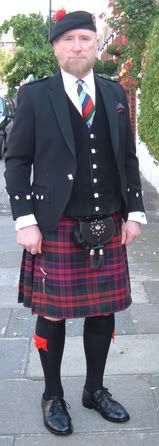|
-
11th June 06, 08:53 AM
#1
Kilted Morning Dress
On 12 May, I started a thread entitled “Kiltic Morning Dress”. Many people helpfully responded, and it concluded with the notion that I would contact the Lord Chamberlain’s Office.
This is a short essay with photographs pulling all that together to get a picture of what goes as semi-formal day wear (i.e. morning dress) in 2006. This is not, of course, Levee Dress or Formal Morning Dress such as would be appropriate for Presentation or as one of the principals at a wedding, but the Highland Dress equivalent of the Morning Dress that would be worn to a Garden Party, a church service, or, in my case, Founders’ Day at the Royal Hospital, Chelsea.
Part of the problem was, of course, that much of what has been written on the subject (such as Dunakin’s book) is stylistically out-of-date. Taste and ‘fashion’ moves on – it’s not static – and so what might have been acceptable in the 1920s-60s would now be considered far too overdressed.
I did indeed write to the Lord Chamberlain’s Office at St James’s Palace, and they referred the letter to the Press Office at Buckingham Palace which replied to me suggesting that I contact Kinloch Anderson at Leith. So I wrote to Kinloch Anderson’s explaining that I’d been passed on to them by the Palace. To date I’ve not received a reply or even an acknowledgement from them.
However, their website is quite helpful: after a bit of hunting around, one can find a bulleted list and a photograph for Semi Formal Wear (Day or Evening). The KA site also gives fairly comprehensive bullet lists with pictures for Day Wear and Formal or Evening Wear. Presumably, as the Palace deferred to KA, this website sets out the definitive statement on what is acceptable dress at the moment and for what sorts of functions.
Actually, the jpeg picture that Presuming Ed provided on the “Kiltic Morning Dress” thread is larger and clearer than the one on the Kinloch Anderson website.
Using this as a basis, and from the conversations I had with others at Chelsea and from what others were wearing, I think we can establish what “goes” at such events in 2006.
Presuming Ed wrote on the “Kiltic” thread:
1) NOT a Prince Charlie. Not to tread on anybody's toes, but IMHO a PC is inappropriate. It's evening formal dress - the equivalent to a dinner jacket, and so is really for events after 6pm or so.
One can see his point here:

2) Were your event to be taking place in the Highlands, or the countryside, I would say that the most suitable suggestion would actually be a tweed kilt jacket and waistcoat…
3) If you're in London, and feel that tweed is a little too rustic, then I would go for a plain black Argyll jacket and waistcoat, day or semi-formal sporran (or even a mask sporran, if you like that sort of thing), hose which tone with the kilt and plain black brogues.
And the KA website states:
Semi Formalwear (Day or Evening)
• Kilt
• Argyll Jacket
• A Black Barathea five button waistcoat
• Plain leather or semi formal Sporran
• Plain wool tie or black bow tie for the evening
• Plain kilt hose
• Flashes
• Ghillie Brogues or plain brogues
• Kilt Pin
• Sgian Dubh
• Plain Shirt
If not wearing the waistcoat a belt is an option.

This advice can be expanded:
- The kilt should be “traditional” (this is a cultural statement after all, and to respect it is a courtesy to the hosts).
- The Argyll jacket should be black with silver, or other, buttons (a couple of ex-Black Watch at Chelsea had regimental brass buttons); the “plain wool tie” can be silk (such as the grey silk tie usually worn at weddings) and Regimental, Club, or School ties are very acceptable.
- The “plain kilt hose” should be black – and this would naturally follow from Ham’s Advice anyway, although checked Argyll pattern was worn at Chelsea

and appears on the website Highland Clans (which also shows the plain grey tie) – or match an appropriate colour in the kilt; although wheat or natural hose seems to work, too.

- Ghillie brogues seem to give way to normal black brogues – known in British military circles as “shoes, highland pattern, black” (from the way quartermasters talk).
- The plain shirt always seems to be white with a turn-down soft collar and often with double cuffs (and cuff links).
- Everybody at Chelsea was wearing a sgian dhubh, and so did not seem to be bothered or intimidated by the current ‘down’ on knives: the police (both Metropolitan and Military) manning the security checks at the entrances took no notice of them. So this must be the de facto rule, although we wait for a clear statement from the politicians who are so preoccupied with the matter at the moment.
- Many people were wearing top hats (black for this sort of occasion). The Highland Dress equivalent was clearly a Balmoral in black or navy blue.

So, I merged Presuming Ed's advice with Kinloch Anderson's and came up with:

Now that I have time to spare, I'll have to take the waistcoat to a tailor and get it adjusted by taking a couple of inches off the bottom to lose the sixth button. And the sleeves of the shirt are too long. Brewin's black hose look OK, though, don't they?
-
 Posting Permissions
Posting Permissions
- You may not post new threads
- You may not post replies
- You may not post attachments
- You may not edit your posts
-
Forum Rules
|
|




















Bookmarks